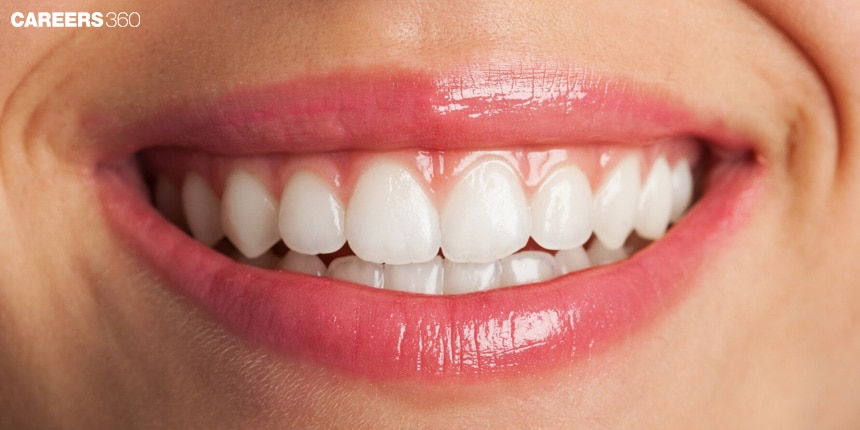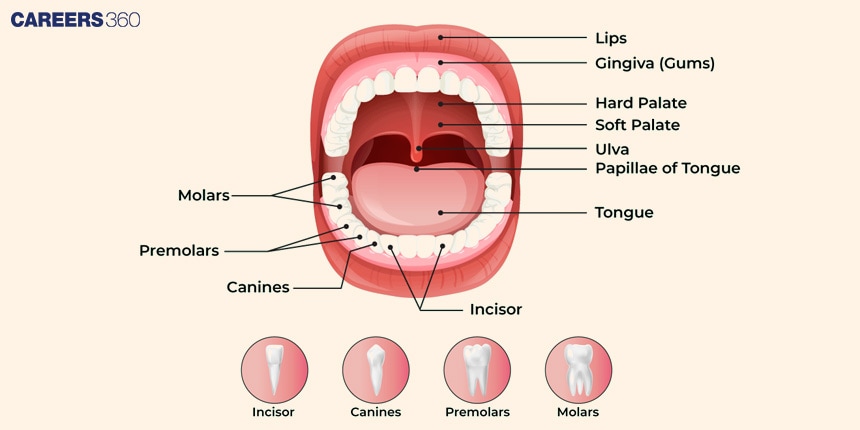Types of Teeth in Humans: Types, Function, Care, Diagram
Human teeth are essential structures in the oral cavity, playing a key role in chewing, speaking, and maintaining facial structure. Humans have two sets of teeth: primary (milk) and permanent teeth, categorized into incisors, canines, premolars, and molars. In this article, teeth, human teeth, types of human teeth, and development and eruption of teeth are discussed. Types of teeth in Humans is a topic of the chapter Digestion and Absorption in Biology.
This Story also Contains
- What is Teeth?
- Human Teeth
- Types of Teeth in Humans
- Development and Eruption of Teeth

What is Teeth?
Teeth perform many vital functions in our daily lives. As part of the ENT features, teeth are essential in the process of eating, articulation, and facial structure. They play an important role in the initial process of digestion where they tear down the food into small parts, which aids in better absorption of nutrients by the body. Teeth also form an important part of clear speech because, during articulation, they help in the formation of sound and enunciate the words properly. There are many types of teeth, all performing certain functions that help keep us healthy and fit. Knowing these differences would help in maintaining dental hygiene and would turn out to be very effective in solving some common dental problems.
Human Teeth
One of the strongest organs in the human body is the tooth. It is mostly made up of minerals (calcium) and proteins (collagen). In addition to aiding in digestion, teeth are crucial for communication. Including the wisdom teeth, an adult will have 32 teeth. The majority of adults will have all of their permanent teeth in place by the time they are 21 years old, with molars being the first to erupt.
Adults have 32 permanent or secondary teeth in total, which comprise the following:
There are eight incisors total—four in the lower jaw and four in the upper jaw.
There are four canines: two in the lower jaw and two in the upper jaw.
There are eight premolars: four in the upper jaw and four in the lower jaw.
There are twelve molars total—six in the upper and six in the lower jaws. There are four wisdom teeth as well.
Since their mother's milk is their main food supply, babies are born without teeth. Milk teeth progressively emerge as the infants begin to wean. By the time a person is six years old, their milk teeth are replaced by permanent teeth. Most children will have all twenty of their primary teeth by the age of three, with the lower incisors being the first of the four tooth types to erupt. These teeth include:
There are eight incisors: four in the lower jaw and four in the upper jaw.
There are four canines: two in the lower jaw and two in the upper jaw.
There are eight molars total—four in the upper jaw and four in the lower jaw.
Also Read-
Types of Teeth in Humans
Humans have four major kinds of teeth, all fitted for some particular function associated with the preparing and articulating of food. They are: Incisors, Canines, Premolars, and Molars.
The following shows their locations, functions, and numbers in both adults and children.
Types of teeth | Location | Function | Number in Adults | Number in Children |
Incisors | Front of the mouth | Cutting and slicing food | 8 | 8 |
Canines | Next to incisors | Tearing and ripping food | 4 | 4 |
Premolars | Between canines and molars | Crushing and grinding food | 8 | 0 |
Molars | Back of the mouth | Grinding and mashing | 12 | 8 |
Incisors
Incisors are pointed, chisel-shaped teeth at the front of the mouth.
There are four upper and four lower incisors in the centre and at the sides of the front of the mouth.
Helps in cutting and slicing food into manageable pieces. Incisors have a single root with a thin cutting edge and are well-suited for biting into food.
They are considered to be the first baby teeth to erupt in children at the age ranging between 6-12 months.
They also happen to be the first to get replaced with permanent teeth at about 6-8 years.
Canines
They are pointed teeth and are located beside the incisors.
There are two upper and two lower canines.
They are located at the "corners" of the dental arches.
Tearing and ripping food, especially tougher textures like meat.
They are long and pointed, crowned, and are single-rooted and the root is the longest of any tooth in humans, thus providing stability and strength.
Generally, they erupt in a child about 16-20 months and are replaced by permanent canines around 9-12 years.
Premolars (Bicuspids)
These are flat-crowned teeth and are located on either side of the canines, in front of the molars.
There are two upper and two lower premolars on each side behind the canines, totalling eight premolars.
Grind and crush food for swallowing.
Premolars are teeth with two cusps, showing on their grinding surface, and they usually have one or two roots. They are exclusively permanent dentition teeth.
They erupt at about 10-12 years of age. They are successors of milk molars of Milk teeth in children.
Molars
Molars are large flattened teeth, located at the back of the mouth.
There are six upper and six lower molars, including wisdom teeth, located at the back of the mouth.
These help in grinding and crushing food to help in digestion.
Molars have a large flat surface area with four to five cusps. They usually have two or three roots.
The first molars come into place at around 6 years of age and the second molars come into place at around 12 years of age.
Wisdom Teeth (Third Molars)
The wisdom teeth are the last molars in the dental series; they usually erupt in late adolescence or early adulthood.
There are two upper and two lower wisdom teeth situated at the very rear of the mouth.
Historically used to grind tough plant fibres, such as roots and leaves. Not as essential today due to dietary and food preparation changes.
Wisdom teeth mostly develop problems resulting from the lack of space in the jaw to accommodate these extra teeth.
This may result in impaction, crowing, or misalignment.
Most of the time, they are extracted to save one from future dental complications.
Finally, wisdom teeth usually erupt during 17-25 years of age, although they may not come out fully in some people.
Human Teeth Diagram

Development and Eruption of Teeth
Normal teeth development follows a definite pattern that begins at the period of infancy and proceeds through early adulthood.
Time Scale of Tooth Development in a Child:
Infant 0-6 months No teeth.
6-12 months Primary teeth bud.
6-7 years First permanent teeth replace primary teeth.
12-13 years permanent teeth erupt.
Late teens to early 20s: Wisdom teeth may erupt.
Also Read-
Recommended Video on Types of Teeth
Frequently Asked Questions (FAQs)
They were quite useful to early humans who had a diet comprising hard foods. Nowadays, when the jaw has become of a relatively smaller size, they crowd and mostly misalign; thus, extractions are frequent.
Twice daily brushing of teeth, flossing once daily, and avoiding sugary foods and juices are good dental hygiene practices. Regular check-ups at the dentist are equally required.
The children's teeth develop from an eruption at 6 months of age to one of the primary teeth, then progress with the permanent ones replacing those at 6-12 years of age. These are completed by an eruption of wisdom teeth later in teenagers and young adults.
Humans have incisors for cutting, canines for tearing and ripping, premolars for crushing, and grinding, and molars for grinding/mashing food.
Children have 20 Milk teeth. Adults have 32 Permanent teeth. Within this number, wisdom teeth are included.